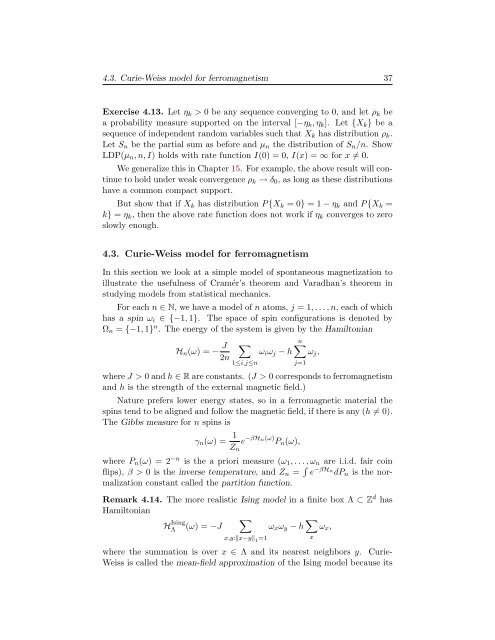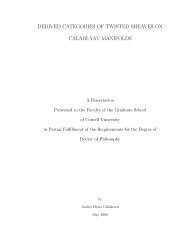A Course on Large Deviations with an Introduction to Gibbs Measures.
A Course on Large Deviations with an Introduction to Gibbs Measures.
A Course on Large Deviations with an Introduction to Gibbs Measures.
You also want an ePaper? Increase the reach of your titles
YUMPU automatically turns print PDFs into web optimized ePapers that Google loves.
4.3. Curie-Weiss model for ferromagnetism 37<br />
Exercise 4.13. Let ηk > 0 be <strong>an</strong>y sequence c<strong>on</strong>verging <strong>to</strong> 0, <strong>an</strong>d let ρk be<br />
a probability measure supported <strong>on</strong> the interval [−ηk, ηk]. Let {Xk} be a<br />
sequence of independent r<strong>an</strong>dom variables such that Xk has distributi<strong>on</strong> ρk.<br />
Let Sn be the partial sum as before <strong>an</strong>d µn the distributi<strong>on</strong> of Sn/n. Show<br />
LDP(µn, n, I) holds <strong>with</strong> rate functi<strong>on</strong> I(0) = 0, I(x) = ∞ for x = 0.<br />
We generalize this in Chapter 15. For example, the above result will c<strong>on</strong>tinue<br />
<strong>to</strong> hold under weak c<strong>on</strong>vergence ρk → δ0, as l<strong>on</strong>g as these distributi<strong>on</strong>s<br />
have a comm<strong>on</strong> compact support.<br />
But show that if Xk has distributi<strong>on</strong> P {Xk = 0} = 1 − ηk <strong>an</strong>d P {Xk =<br />
k} = ηk, then the above rate functi<strong>on</strong> does not work if ηk c<strong>on</strong>verges <strong>to</strong> zero<br />
slowly enough.<br />
4.3. Curie-Weiss model for ferromagnetism<br />
In this secti<strong>on</strong> we look at a simple model of sp<strong>on</strong>t<strong>an</strong>eous magnetizati<strong>on</strong> <strong>to</strong><br />
illustrate the usefulness of Cramér’s theorem <strong>an</strong>d Varadh<strong>an</strong>’s theorem in<br />
studying models from statistical mech<strong>an</strong>ics.<br />
For each n ∈ N, we have a model of n a<strong>to</strong>ms, j = 1, . . . , n, each of which<br />
has a spin ωi ∈ {−1, 1}. The space of spin c<strong>on</strong>figurati<strong>on</strong>s is denoted by<br />
Ωn = {−1, 1} n . The energy of the system is given by the Hamilt<strong>on</strong>i<strong>an</strong><br />
Hn(ω) = − J<br />
2n<br />
<br />
1≤i,j≤n<br />
ωiωj − h<br />
n<br />
ωj,<br />
where J > 0 <strong>an</strong>d h ∈ R are c<strong>on</strong>st<strong>an</strong>ts. (J > 0 corresp<strong>on</strong>ds <strong>to</strong> ferromagnetism<br />
<strong>an</strong>d h is the strength of the external magnetic field.)<br />
Nature prefers lower energy states, so in a ferromagnetic material the<br />
spins tend <strong>to</strong> be aligned <strong>an</strong>d follow the magnetic field, if there is <strong>an</strong>y (h = 0).<br />
The <strong>Gibbs</strong> measure for n spins is<br />
γn(ω) = 1<br />
Zn<br />
j=1<br />
e −βHn(ω) Pn(ω),<br />
where Pn(ω) = 2 −n is the a priori measure (ω1, . . . , ωn are i.i.d. fair coin<br />
flips), β > 0 is the inverse temperature, <strong>an</strong>d Zn = e −βHn dPn is the normalizati<strong>on</strong><br />
c<strong>on</strong>st<strong>an</strong>t called the partiti<strong>on</strong> functi<strong>on</strong>.<br />
Remark 4.14. The more realistic Ising model in a finite box Λ ⊂ Zd has<br />
Hamilt<strong>on</strong>i<strong>an</strong><br />
H Ising<br />
Λ (ω) = −J <br />
ωxωy − h <br />
ωx,<br />
x,y:x−y 1 =1<br />
where the summati<strong>on</strong> is over x ∈ Λ <strong>an</strong>d its nearest neighbors y. Curie-<br />
Weiss is called the me<strong>an</strong>-field approximati<strong>on</strong> of the Ising model because its<br />
x
















